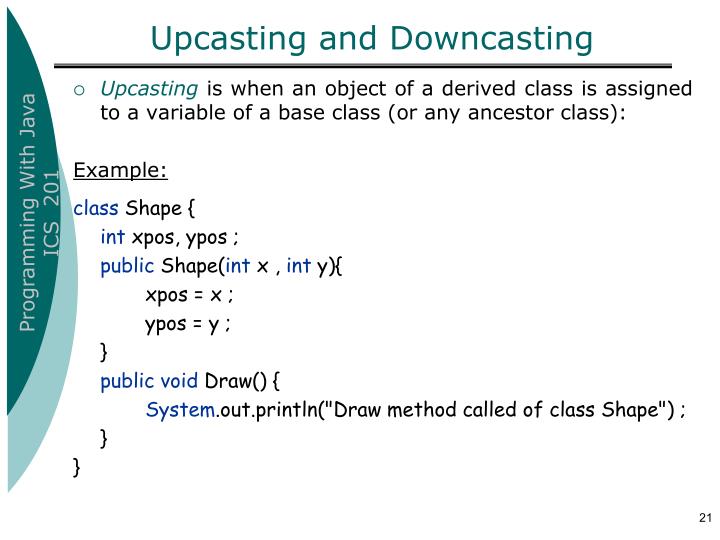
When we want to call a method declared in a sub-class via a reference of the superclass type, we have to perform explicit casting or downcasting. Using the vehicle variable we called the method from the subclass ( Car), which is declared in the parent class ( Vehicle). In the above example, we inherit and override the printMaxSpeed method in the Car class, and then in the main method, we assign a Car object to a reference of Vehicle type. Polymorphism Polymorphism is one of the most powerful mechanisms of OOP Class Shape Class Circle Client Code: Upcast Consider the following statement: Upcast: 1) only cast a class to its base class, 2) only consider the static type of an object There are two type conversions: Downcast Downcast: only change the static type of an object. Vehicle vehicle = new Car() // upcasting - casting child class to parent class The parent-to-child type casting is known as Upcasting, and child-to-parent type.
#Upcast vs downcast code
Example The first two assignments in the following source code section are up casts: The instance operator NEW creates a result with the static and dynamic type c2, which can be assigned to the more general reference variable oref1. Upcasting and Downcasting are the types of object-type casting in Java. Using this reference, we can access objects and fields within a subclass, but only those inherited from the superclass. One obsolete form of down cast is the statement MOVE with the addition TO. When performing upcasting, we assign an object of a sub-class to a reference of superclass type. Downcasting – When we want a Parent class reference to access a method or field declared in a child class, we must explicitly cast the parent object to the child object.We can access a method or field from the parent class via a child object. Upcasting – Java permits an object of a subclass type to be treated as an object of any superclass type.In Java, we have two ways of object typecasting: Upcasting and Downcasting. Downcasting What are Upcasting and Downcasting in Java?.What are Upcasting and Downcasting in Java?.User Registration, Log in, Log out – Video Tutorials.The program writes "100, 80, 120, 80" to the standard output. The program writes "120, 80, 100, 80" to the standard output. The program writes "120, 80, 120, 80" to the standard output.


The program writes "100, 100, 100, 100" to the standard output. Klik untuk melihat definisi asal«upcast» dalam kamus Corsica.

This allows us to be able to access the functions within the Child class, which the Base Class Pointer should not be able to access normally. Upcastis also directed or thrown upwards. In short, Upcasting occurs when we attempt to cast a Child to a Parent, Up the Hierarchy. Other definition of upcastis the section of strata that has been displaced upwards. The first definition of upcastin the dictionaryis material cast or thrown up. The program writes "120, 120, 120, 120" to the standard output. Upcast juga diarahkan atau dibuang ke atas. The program writes "120, 100, 120, 100" to the standard output. Note: The classes Vehicle and Car are in two separate files, namely Vehicle.java and Car.java:Ĭar.java: public class Car extends Vehicle What happens when the following program is compiled and run? The method returns mc.x + mc.y = 12 + 6 = 18. The statement mc.y += 2 increments the value of y by 2. The statement mc.x += 9 increments the value of x by 9. The statement (mc.method(mc)) invokes the method. By using the statement this.x = x++ the value of x remains x, while the statement this.y = ++y increments the value of y by one. The statement M圜lass mc = new M圜lass(3, 3) creates the object mc. Both increment the value of the variable by one, but ++y increments the value by one before the current expression is evaluated, while x++ increments the value of the variable by one after the expression is evaluated.

X++ and ++y are very similar, but not exactly the same. Before we start with this week's quiz, here is the answer to Java Quiz 7: Using Unary Operators.


 0 kommentar(er)
0 kommentar(er)
